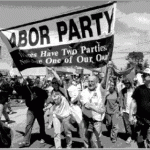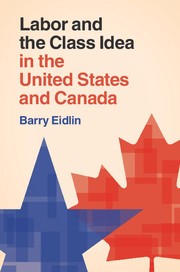Why No Labor Party Here?

Why has union membership been on the decline in the United States since the early 1950s? Why is the dominant culture in this country one that values ideas of “free enterprise” and individual economic mobility rather than the idea of class interests and struggle? How can we build working-class power and reverse economic inequality and in the process change our political discourse and culture to one that is not hostile towards working class solidarity?
Labor and the Class Idea in the United States and Canada
By Barry Eidlin
Cambridge University Press; 349 pages
May 3, 2018
Paperback: $29.99
ISBN: 9781316227183
Barry Eidlin, a leftwing labor sociologist, tackles these questions by asking a different question: Why do fewer U.S. workers belong to unions compared to Canada, a country that has weathered some of the same industrial changes? Labor and the Class Idea in the United States and Canada investigates the different outcomes of the labor movements of the 1930s and 1940s by comparing the two countries over the course of the 20th century.
The comparative approach is useful because until the early 1950s, labor union density tracked very closely in both countries. Yet Canadian union density, at 28.4% in 2016, is nearly three times that of the U.S. rate.
Eidlin contends that there are many incomplete explanations: Canada has different labor laws, employs a different (parliamentary) political system, and historically racial divisions are of a smaller scale than in the United States. Labor unions in the U.S. context are treated as “special interests” vying for favoritism rather than representatives of the broader working class.
What made the United States this way? How and why is Canada different?
Essential Data
The book presents some very compelling data culled from valuable archival research to help filter the many causes from the ripple effects, effectively exposing key aspects of U.S. and Canadian political history that we still contend with today.
Eidlin focuses on periods where measurables like union membership and independent left third-party political support tracked similarly in both countries but then dramatically diverged. He also examines contextual data around strike activity, public opinion concerning how industry should be managed, public support of unions and changes in employment and industry in both countries.
The data are essential for peeling away various incomplete narratives for why union density has not declined nearly as much in Canada as in the United States and what this tells us about the working class and the U.S. political system. The book takes the reader through a process of eliminating explanations by testing them with data and includes an investigation of the stories behind the data — the people, organizations and institutions that grappled with an unprecedented capitalist crisis, mass unemployment, and rising worker unrest during the 1930s Great Depression.
Rather than a detailed historical examination of social forces, however, the aim of the book is to compare how and when the data diverge in the two countries and then look to history more broadly for the events that coincide. This approach has its limitations. A more detailed historical analysis alongside the data would have been desirable to fully investigate the complexity of the period of social upheaval that produced such different outcomes. Nonetheless, the analysis of this data is very effective at eliminating various incomplete explanations.
Coercion vs. Cooptation
Eidlin’s primary conclusions rest in how workers’ movements and class interests came to be represented and then articulated in political party systems in very different ways at different moments in history and how articulation later undermined or supported class organization and interests over the long-term.
Class interests were incorporated into political parties in vastly different ways, primarily, the book poses, because of how ruling class interests chose to respond to labor uprisings.
Specifically in Canada, the ruling class refused to incorporate labor into their parties during the rising labor unrest of the 1930s and only much later became willing to support voluntary labor law regimes.
This was part of a response meant to coerce labor into submission. Left with no establishment political party to take up their demands, workers eventually formed their own party, the Cooperative Commonwealth Federation (CCF, later the New Democratic Party), to challenge the ruling parties, particularly the Liberals.
In contrast, in the United States the Democrats under the Franklin Delano Roosevelt administration saw an opportunity to bring labor unions into the fold by co-opting key economic demands (leaving out many other social demands) and making them part of a coalition of a plurality of interests, interests which included racist southern Democrats and capitalists from key sectors.
Through their support for FDR, U.S. unions benefited greatly from the establishment of labor laws in the 1930s that included rights to organize and outlawed company unions. As the book very effectively details, however, the labor law regime put in place was focused on the adjudication process of individual worker rights, not resolving class conflicts between employers and groups of workers.
In fact, this regime immediately caused more intra-class strife by pitting unions against each other in battles for jurisdiction. A key feature was that rather than being overseen by representatives from employers (capitalists) and unions (working class) as in Canada, labor relations boards were chosen from the legal community by elected officials. Their decisions were therefore heavily determined not only by the party in power, but by the capitalists who could influence those parties.
By the early 1950s the Democrats were no longer in control — something that might seem inevitable to readers today, but clearly was not well anticipated by labor leaders and even the functionaries of the left at the time. By then unions had grown tremendously under the new rights, but also transformed themselves into bureaucracies focused on the adjudication process.
U.S. labor leaders had completely abandoned the idea of a labor party long before the Democrats lost control of the government. The merger of the AFL and CIO in 1955 was a defensive move, the first of many. In contrast, in Canada during this time, labor law was just being established, and it was superior in many ways to the U.S. in part because it was more insulated from party influence.
Employers on the Offensive
The book is very effective at exposing how the employer offensive was always going on, even immediately following the 1935 passage of the Wagner Act (which protected union organizing), countering the narrative that this offensive against labor began in earnest only in the 1970s. Through the comparative data, Eidlin bridges the time period leading up to the New Deal with that of the steepest decline in union density.
The coopting of trade union demands at the height of labor militancy in the 1930s was clearly capitalist- class interests at work. The unions and the Communist Party USA, believing they had a seat at the table, supported a no-strike policy during the second world war. The postwar Taft-Hartley Act (outlawing secondary boycotts and allowing state “right-to-work” laws) and McCarthyism followed.
It becomes evident that it is important not to reduce labor’s success at growth to external factors: the lack of an employer offensive or a particular labor law regime.
To do so is to overlook the other significant kinds of power: workplace, organizational and political that drove union growth in the late 1930s and 1940s. Workers were radicalized, striking and occupying workplaces, and a socialist and communist left were more organized in the workplace than at any point in history. Unions were therefore well-positioned to take advantage of legal recognition procedures.
Canadian politicians and capitalists were not more enlightened or reasonable than their U.S. counterparts. Despite intense strike activity and labor upsurge in the same period leading up to WW II, a labor law regime was not established until the 1950s.
When it eventually was won, it was modeled in a way that accepts and reinforces class interests — overseen by labor and management representatives, with processes in place to bring both sides to compromise more even handedly than in the politicized U.S. setup.
Canadian unions, although impacted by similar redbaiting and global political and economic changes as in the United States, had established a party, the NDP, that was not a coalition with capitalists. By doing so, their political party could pose enough of a political threat to force the capitalist-dominated parties to accept reforms.
Unions were also more allied with other segments of the working class, more influenced by the socialist left, and later more integrated with social movements for civil rights in the 1960s, which were conversely more rooted in class struggle than movements in the United States.
This enabled the labor movement, through a labor-controlled political party, to preserve its ability to independently contest for power against Liberals and other ruling class enemies, even after labor laws and contracts had tamped down worker unrest.
Of course, since that time the NDP itself has been somewhat corrupted by neoliberal tendencies. The difference is that U.S. unions never achieved political articulation independent from the Democratic Party and were limited from the start by employer interests within their coalition. FDR and his party were credited with the New Deal and its many programs while unions are often seen as merely the beneficiaries.
Southern racists got what they wanted too: a labor law that excluded domestic and agricultural workers, overwhelmingly Black workers at the time. Today, even if Democrats have power over all three branches of the federal government — as they did in the first two years of the Obama presidency — passage of reforms that benefit unions and workers is very modest.
Party leaders consistently seek market-based solutions for problems of inequality and do not want to be associated with anything on the scale of the New Deal that could be characterized as redistribution or class warfare.
Why Not a Labor Party?
The debate over whether to form a labor party within the various factions of the U.S. labor movement in the 1930s is not really the book’s focus. Nevertheless, its conclusions are a compelling case for why a labor party is necessary for a strong labor movement.
Proving that a labor party is necessary is not the same as fully understanding why it didn’t happen at a rare time when it was arguably quite possible. Perhaps it was out of the purview of the book, but there was not much discussion of why the left of the labor movement, before McCarthyism, did not prevail in launching a labor party.
One limitation of looking primarily at structural changes and outcomes is that it assigns most of the agency for what happened (or did not happen) to the capitalists. With a more in-depth historical analysis as a counterpart to the data, we could better understand the complex agency of unions, communists, and other social forces.
For example, the Communist Party went through a change in leadership prior to the New Deal (as well as many other internal battles around labor work), and William Z. Foster, a long-time agitator in many unions, then organizer for what became the CIO and proponent of a labor party, was no longer in leadership. He was replaced by Earl Browder, a bureaucrat.
Browder enthusiastically supported the New Deal coalition. He also supported the no-strike policy during the war and in 1945 was removed (at Moscow’s direction) for moving toward dissolving the party itself.
This all transpired, amazingly, during the peak membership of the party — much of its growth having been spurred by anti-fascism, civil rights struggles and labor organizing.
This disconnect inside the largest left organization in U.S. history — between party officials and the movements they had helped organize — seems very significant in the face of what the book lays out. Foster and Browder are mentioned at various moments in the book, but very briefly, and they are not included in the index (although the CPUSA is).
It is important to note that the conflicting perspectives of Foster and Browder reflected larger forces inside and outside the Communist Party. While they did not shape the trajectory of the party so much as reflect it, they did so through very different orientations to the ruling class, labor officialdom, and rank and file.
The book mentions how the agricultural policy of the Roosevelt administration encouraged the absorption of farm-labor groups into the party, particularly by excluding Blacks and immigrants from labor laws. But there isn’t a discussion of farm-labor populist movements also being fertile ground for fascist organizing.
Civil Rights and the fight against segregation were particularly set back by many New Deal policies, including racist housing policies that would impact Black families for generations. William Z. Foster, in an essay titled “The New Political Bases for a Labor Party in the United States” published just a couple weeks before the Wagner Act was passed in 1935, described the situation:
“A severe struggle will be necessary because the bourgeoisie, which has no intention of granting the demands of the workers and poor farmers, will not sit idly by while they create a broad labor party to fight for these demands. Already, indeed, it is vigorously attempting to make use of these discontented masses so that they may be used for their own further enslavement. Fascism, supported by the big capitalist elements, is now growing with great rapidity in the United States. A whole crop of well-financed fascist and semi-fascist leaders, with the wildest demagogy and reckless promises, are working to confuse the discontented masses and to secure organized control over them. And, unfortunately, they are only too successful-undoubtedly millions of oppressed workers and farmers are already looking to them for leadership and organization.
The same essay discusses many of the questions in Eidlin’s book — why there was not already a labor party in the United States and even how countries where working class demands had not yet been coopted had developed more militant class struggles leading to revolutionary movements and articulation via labor parties. Foster also touches upon the particular character of U.S. working-class political struggle up to that point, which clearly could have figured into FDR and the Democrats’ political calculations in forming a New Deal coalition:
“The grievances that pressed them most, and often these were very severe — chiefly long hours, low wages, bad working conditions — were mainly of an economic character. Hence, historically, the struggle of the American working class has almost always been limited to that for economic demands, and did not go beyond the bounds of simple trade unionism, which did not, however, prevent it from often being extremely bitter in character. And hence, also, for two generations all attempts to found a strong Socialist or labor party resulted in failure.”
Just as the cooptation was in process, Foster was vehemently trying to make the case for the feasibility and strategic need for a labor party that would take up much broader classwide political demands — including equality for Blacks, fighting white supremacy, the cost of housing, cost of living, and the plight of poor farmers.
I can only conclude that his experience as an organizer helped him understand first-hand why this was strategic and why narrow economic interests or demands — even if widely felt by the working class — are often the easiest for capitalists to coopt or neutralize, avoiding bigger contests for structural change to power relations and decision making (those other demands).
The political demands of a movement capable of competing with capitalist parties would need to unify the fragmented working class in a country like the United States, which at the time was far more predisposed for such divisions than its neighbor to the north.

Book author Barry Eidlin is a comparative historical sociologist and assistant professor at Montreal’s McGill University, researching and writing about class, politics, inequality, and social change. Eidlin’s major current project revisits the question of “why no workplace democracy in America?” His work has appeared in “New Labor Forum, Labor Studies Journal, American Sociological Review, Against the Current and Politics and Society. His review of Kim Moody’s seminal On New Terrain: How Capital is Reshaping the Battleground of Class War is available on Portside HERE.
[Reviewer Meredith Schafer has gone on strike, served as a shop steward, local union officer, organizer and campaign researcher for the last 20 years. She lives in Virginia.]
Information on the bimonthly Against the Current and its sponsoring organization, Solidarity: A Socialist, Feminist, Antiracist Organization, is available HERE.

